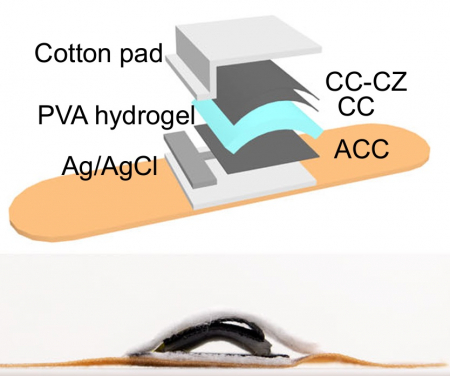Media
HKU Mechanical Engineering researchers develop miniaturised electric generators based on hydrogels for use in biomedical devices
22 Apr 2024
The development of engineered devices capable of harvesting the body’s mechanical motion and converting it into electricity is crucial for the functioning of bioelectronics.
Mechanoelectrical energy conversion offers a promising solution for powering miniaturised biomedical devices, such as cardiac pacemakers, brain stimulators, wearable drug delivery systems, and more.
Although there have been various proposals for miniaturised mechanoelectrical converters in the past decade, the challenge of achieving both high electrical output and body-conformal device structures remains.
A research team led by Professor Lizhi Xu from the Department of Mechanical Engineering in the Faculty of Engineering at the University of Hong Kong (HKU) has developed a high-performance mechanoelectrical energy converter based on hydrogels, a class of water-rich soft polymeric materials.
The researchers used an ion-loaded hydrogel sandwiched between two electrodes to construct the electric generator.
“The key is to use structural and chemical asymmetry to amplify the separation of charges in the ion-loaded hydrogel.” said Professor Xu, adding, “with these asymmetric designs, the electrical output of the hydrogel generators was enhanced by orders of magnitudes, which is important for the powering of miniaturised biomedical devices.”
Under mechanical compression applied to the device, the positively charged ions and negatively charged ions in the hydrogel will move at different rates. The separation of electric charges will generate voltage and current, which can be utilised by the external circuit.
The research team further exploited asymmetric designs in the device to greatly enhance the electrical output, reaching an unusually high level of 5.5mA/m2 and 916 mC/m2 per cycle, far beyond those of other systems. For example, it is about ten folds higher than triboelectric nanogenerators and other flexible generators.
“Hydrogels are good body-conformal device structures because they are soft, flexible, and can be designed to mimic the properties of biological tissues. They are highly biocompatible and able to conform to the shape of various tissues in the body.” Professor Xu said.
In the study, a soft patch for controlled drug release was demonstrated. The technology can be further applied to many other biomedical devices such as cardiac pacemaker, wearable health monitors, VR/AR interfaces, etc.
The research was published in Nature Communications, in an article entitled “A high-current hydrogel generator with engineered mechanoionic asymmetry”.
Link of the paper: https://www.nature.com/articles/s41467-024-45931-7
Research team website: https://xulizhi.hku.hk
About the HKU Faculty of Engineering
The Faculty of Engineering is one of the founding Faculties of The University of Hong Kong established in 1912. Since its foundation, the Faculty has kept pace with developments in the engineering world and is always at the forefront of engineering research, evolving into one of the largest Faculties at the University with five departments providing undergraduate, postgraduate and research degrees in a wide range of important fields of modern engineering, technology and computer science. The faculty is dedicated to offering students a comprehensive education that goes beyond knowledge of cutting-edge technology, and strives to equip graduates with excellent communication and social skills, an innovative mindset, a commitment to lifelong learning, professional integrity, and international exposure. For more information, visit https://engg.hku.hk.
Media Enquiries:
Faculty of Engineering, HKU
Ms Charis Lai (Tel: 3917 1924; Email: chariskc@hku.hk)



